Introduction
In an age where data drives decision-making and operational efficiency, the ability to maintain up-to-date insights is crucial for organizations striving to stay competitive. Scheduled refresh in Power BI emerges as a powerful solution, allowing teams to automate data updates and ensure reports reflect the latest information. This functionality not only minimizes the risk of human error but also enhances consistency across reports—two significant challenges that often hinder effective data management.
By delving into the intricacies of scheduled refresh, from prerequisites to troubleshooting common issues, organizations can unlock the full potential of their data analytics efforts. Embracing best practices and leveraging innovative tools such as Robotic Process Automation (RPA) can further streamline these processes, empowering teams to focus on strategic initiatives rather than time-consuming manual tasks.
As businesses prepare for the evolving landscape of business intelligence, understanding and optimizing scheduled refresh capabilities in Power BI is essential for informed decision-making and sustained growth.
Understanding Scheduled Refresh in Power BI
The feature that allows organizations to schedule Power BI refresh is vital, as it enables automatic updates of datasets at defined intervals, ensuring that reports reflect the most current information. This capability is especially advantageous for businesses that rely on real-time information analysis for informed decision-making. By implementing a schedule power bi refresh, teams can eliminate the need for manual updates, significantly reducing the risk of errors and enhancing consistency across reports—key challenges often faced due to time-consuming report creation and data inconsistencies.
Significantly, it can take Power BI up to 60 minutes to update a semantic model when using the ‘Refresh now’ option, emphasizing the time efficiency gained through scheduling.
Furthermore, ensuring that Power BI is configured to send update failure notifications directly to your mailbox can help address any issues promptly. It’s also crucial to verify that ‘Gateway and cloud connections‘ are routed and applied correctly, as this can affect the overall effectiveness of the update strategy. A strong governance strategy is essential to maintain consistency and mitigate confusion, addressing prevalent issues in report accuracy.
As highlighted by industry expert Sal Alcaraz, organizations utilizing a Premium license can perform up to 48 refreshes per day, with the potential to increase this limit by enabling an XMLA Endpoint. Grasping the complexities of planned updates is essential for optimizing Power BI’s functionalities, particularly as companies aim to schedule Power BI refresh to utilize the newest enhancements and features in 2024. Furthermore, the General Management App improves your reporting strategy by offering comprehensive management, custom dashboards, and smooth information integration, tackling the frequent problem of reports lacking actionable guidance.
A case study titled ‘Active Reports and Viewer Counts’ demonstrates the effectiveness of regular updates, where metrics such as total views and total viewers were tracked, leading to improved report management and enhanced user engagement. This emphasizes the significant effect that a well-executed update strategy can have on data accuracy and operational efficiency within your organization, reinforcing the importance of real-time data analysis in business intelligence.
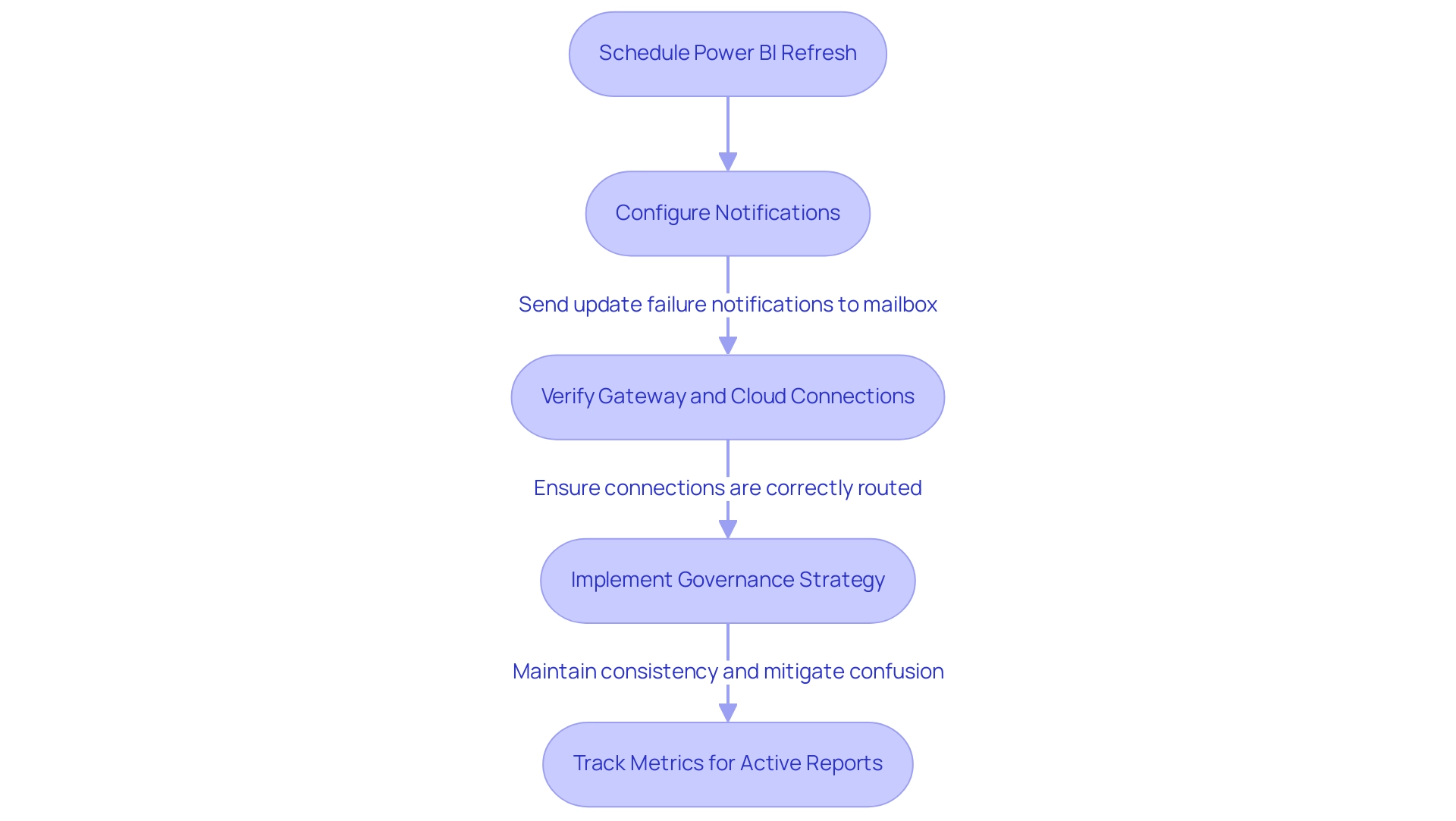
Prerequisites for Setting Up Scheduled Refresh
To successfully establish a timed refresh in BI, it’s crucial to meet the following prerequisites:
- A Power BI Pro license is essential to schedule Power BI refreshes in the Power BI Service. Be mindful that if the license remains inactive for an extended period, such as six months, it may not be utilized effectively.
- Source Compatibility: Verify that your sources are suitable for scheduled refreshes. Commonly supported sources include Azure SQL Database, SharePoint Online, and SQL Server.
- Gateway Configuration: For on-premises information sources, ensure that an On-premises Gateway is configured. This gateway is essential for facilitating seamless information transfer between your sources and Power BI.
- Information Structure Enhancement: Enhance your information structure for performance. Larger datasets can result in extended update times, so efficient modeling is key.
By meeting these prerequisites, you will be well-equipped to schedule Power BI refresh, which will enhance the efficiency of your operations and address the prevalent challenges of time-consuming report creation and inconsistencies that can undermine trust in your insights. To further enhance actionable guidance, consider utilizing Power BI features such as alerts and dashboards that provide real-time insights and direction. Additionally, integrating RPA tools can automate repetitive information handling tasks, streamlining your processes and allowing your team to focus on analysis rather than report creation. As noted by experts, many of the capabilities discussed here are not available to Fabric administrators, underscoring the need for the right licensing and setup. Organizations that have effectively met these requirements have reported significant improvements in their information management processes, facilitating information-driven decision-making that can drive growth and innovation.
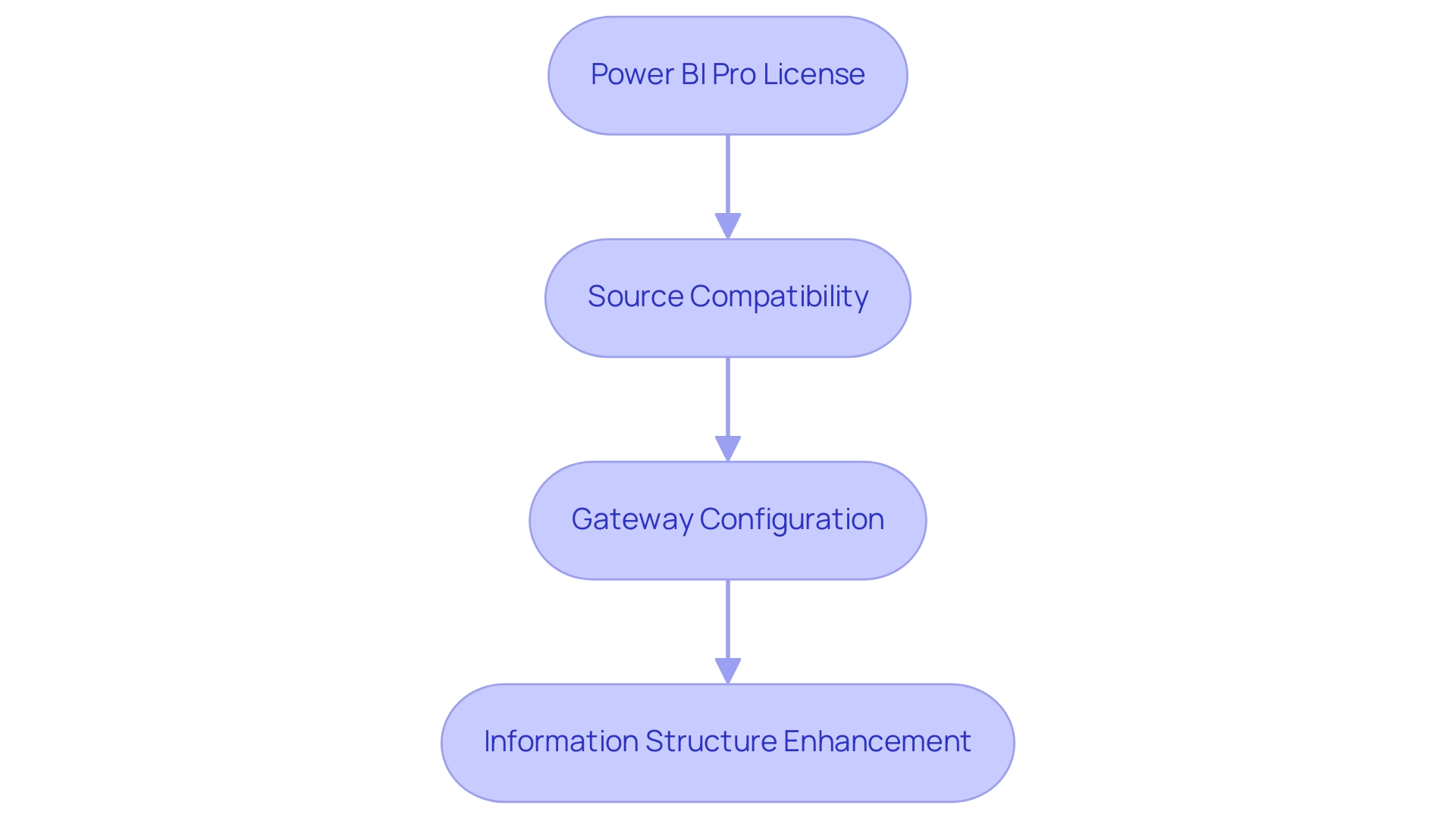
Step-by-Step Guide to Configuring Scheduled Refresh in Power BI Service
Configuring a schedule power bi refresh in the BI Service is essential for maintaining up-to-date reports, thereby enhancing your ability to leverage data-driven insights for operational efficiency. RPA solutions can play a pivotal role in automating the scheduling and management of these data refreshes, further streamlining the process. Follow these detailed steps to ensure a seamless setup:
- Log into Power BI Service: Begin by navigating to the Power BI Service at https://app.powerbi.com and logging in with your credentials.
- Select Your Dataset: In the left navigation pane, click on ‘Datasets’ to locate the specific dataset you plan to update.
- Access Dataset Settings: Click on the ellipsis (…) next to your selected dataset, then choose ‘Settings’ to access the configuration options.
- Configure Scheduled Update: Scroll down to the ‘Scheduled update’ section. Here, toggle the ‘Keep information updated’ switch to ‘On’ to enable automatic update.
- Set Update Frequency: Choose your desired update frequency, either daily or weekly, and select the appropriate time zone. Indicate the moments when you wish the update to take place for optimal information retrieval.
- Apply Changes: Click ‘Apply’ to save your settings. In this section, you can also choose to set up email notifications for any update failures, providing you with timely updates.
By following these steps, you will successfully schedule power bi refresh for your dataset, which will ensure that your reports reflect the most recent information available. This proactive approach not only streamlines report creation but also minimizes inconsistencies—common challenges faced by operations directors. Remember, a semantic model can utilize only a single gateway connection, so ensure that all necessary data source definitions are included in that same gateway.
For new updates, it is advisable to utilize the certified Supermetrics connector, as this helps streamline the update process. Keep in mind that the business intelligence tool will deactivate your update schedule after four consecutive failures, making it essential to monitor your update settings for consistent performance.
As Denys Arkharov, a BI Engineer at Coupler.io, states, “A notable achievement in my career was my involvement in creating Risk Indicators for Ukraine’s ProZorro platform, a project that led to my work being incorporated into the Ukrainian Law on Public Procurement.” This emphasizes the importance of efficient information management in BI. Moreover, the case study on utilizing BI Gateway for On-Premises Information Sources illustrates how mapping the gateway’s information source to the report’s semantic model facilitates the ability to schedule power bi refresh for reports using on-premises information sources.
Businesses that struggle to leverage these data-driven insights often find themselves at a competitive disadvantage, making the integration of RPA solutions crucial for optimizing data management and operational efficiency.
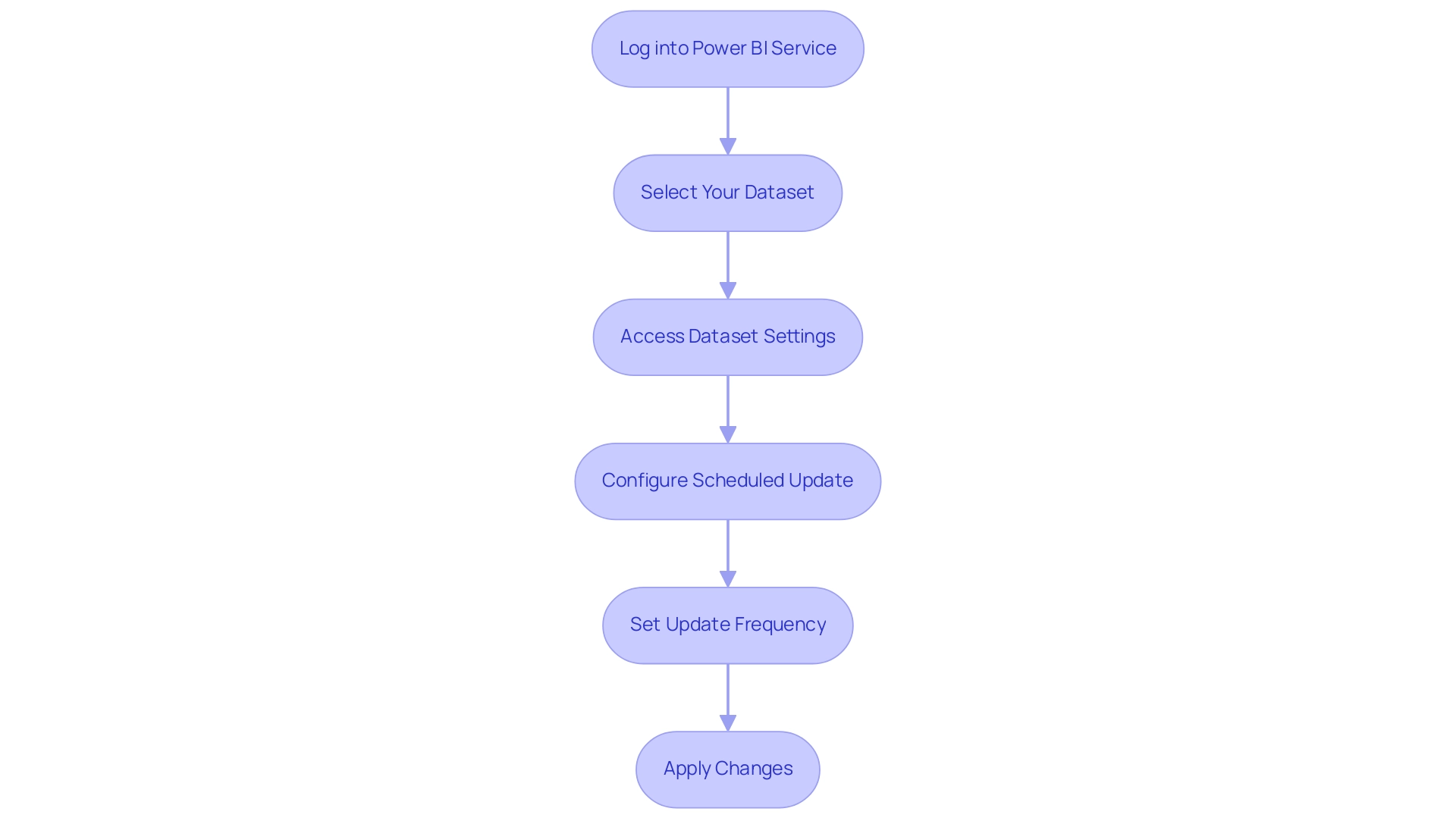
Troubleshooting Common Issues with Scheduled Refresh
When handling planned refreshes in Power BI, several common issues may arise, but with the right strategies, you can troubleshoot effectively:
-
Refresh Failures: If a scheduled refresh fails, the first step is to examine the error message in the refresh history. Often, such failures arise from invalid credentials or source connectivity issues. Confirm that your credentials are accurate and that the information source is accessible. Rena, from Community Support, emphasizes a crucial concern:
When did the last planned update and manual update occur independently? When SQL Server (the count: 4,232,405) is updated? Is it possible that the planned refresh operation has concluded, but the information in SQL Server has not been updated yet? Being aware of these nuances can help clarify the situation and emphasizes the importance of monitoring SQL Server updates in relation to the scheduled Power BI refresh, particularly in a landscape where a lack of governance strategy can lead to inconsistencies, confusion, and mistrust.
-
Long Refresh Times: If your refreshes are taking longer than anticipated, optimizing your model is essential. This can be achieved by reducing dataset size or filtering out unnecessary data. Additionally, ensure that your On-premises Data Gateway is properly configured and up to date. Regular testing of update scenarios is a best practice that helps prevent last-minute issues. The case study on Best Practices for Power BI Update Operations emphasizes that to schedule Power BI refresh, proactive management and regular testing can significantly enhance the reliability and efficiency of update processes. Remember, in today’s data-rich environment, efficiency in managing these processes is vital to avoid the pitfalls of time-consuming report creation and to leverage the full potential of Business Intelligence for informed decision-making.
-
Email Notifications: Not receiving notifications for update failures can hinder your ability to respond promptly. Verify that your email settings in the dataset configuration are accurate. Ensure that the email address is valid and that notifications are enabled. By taking these steps, you can maintain an agile decision-making process and ensure precise information reporting, transforming raw information into actionable insights that drive growth and innovation. The possible misunderstanding and distrust that can emerge from inconsistencies in information emphasize the importance of tackling these problems proactively.
Comprehending these frequent issues and their resolutions will enable you to efficiently schedule Power BI refresh for your planned updates, thus improving information accuracy and operational effectiveness.
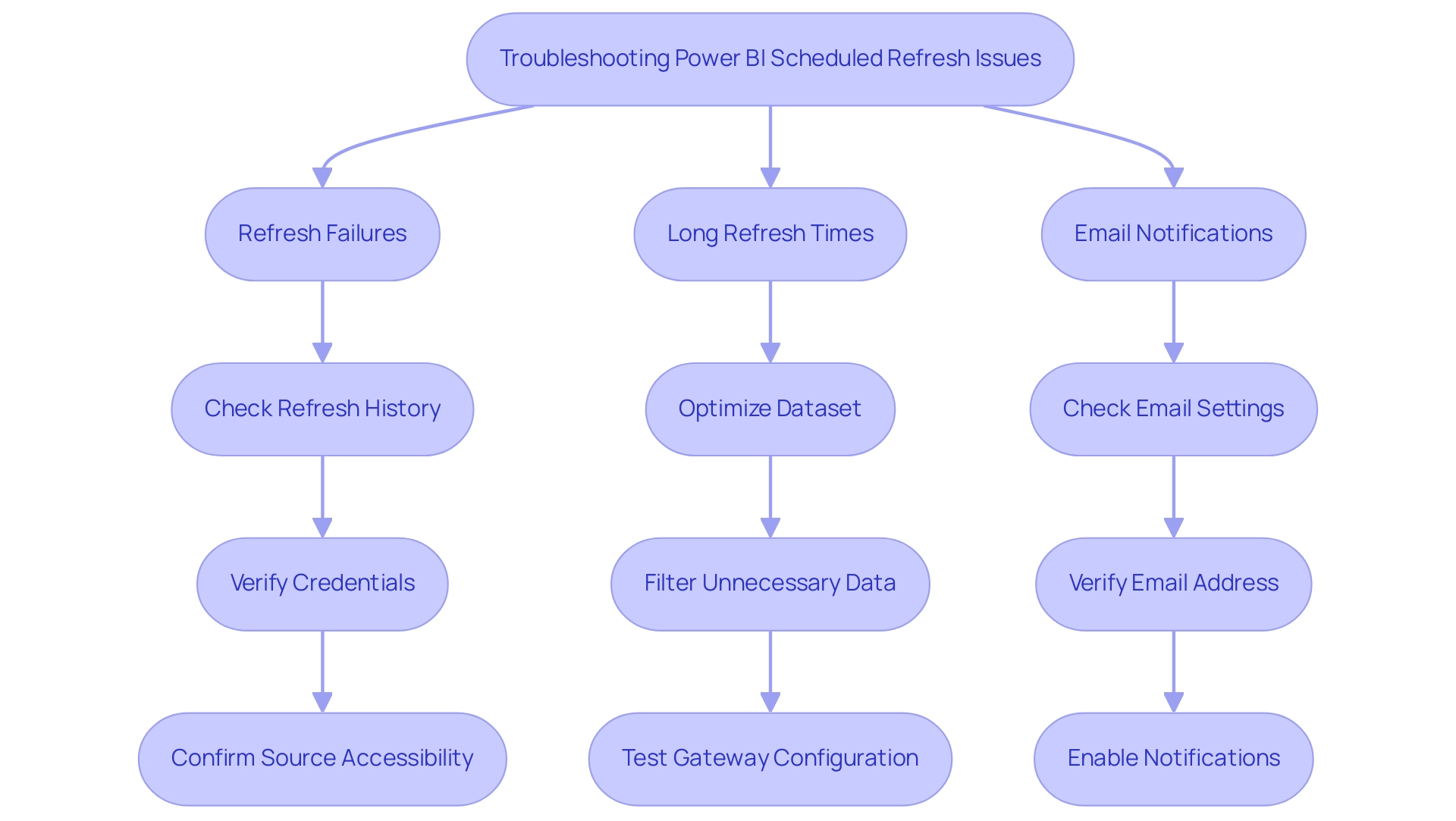
Best Practices for Optimizing Scheduled Refresh in Power BI
To enhance the efficiency of your scheduled refreshes in Power BI while addressing the challenges of manual, repetitive tasks, consider implementing the following best practices while leveraging Robotic Process Automation (RPA) to automate workflows:
-
Limit Dataset Size: Streamline your update processes by decreasing the amount of information updated at each interval. This can be achieved by applying filters or aggregating data whenever possible.
Smaller datasets not only update more rapidly but also enhance overall performance. Additionally, limiting displayed numbers to four numerals and decimal points to two decimal points improves readability and consistency across reports. -
Schedule Off-Peak Hours: Strategically set your update schedules for off-peak hours.
This timing minimizes the burden on system performance and ensures that sufficient resources are available for other critical tasks, leading to smoother operations. -
Monitor Update Performance: Consistently review the update history to identify trends in update durations and any failures.
Examining this information enables you to make informed choices regarding management and update strategies, ultimately enhancing performance.
By integrating RPA, this monitoring can be automated, freeing your team to focus on strategic initiatives and reducing the errors associated with manual oversight. -
Utilize Incremental Update: For larger datasets, explore the option of incremental update.
This technique allows you to update only the information that has changed since the last refresh, rather than reloading the entire dataset, thus improving efficiency.
As highlighted by community expert Dino Tao, it is essential to monitor and optimize your model and queries to mitigate potential performance issues that can arise from frequent intraday refreshes. -
Consider Performance Impacts: Be mindful of the performance ramifications of frequent intraday refreshes, especially with larger datasets.
Dino Tao emphasizes the importance of ensuring consistency between historical and real-time information segments, suggesting that implementing a hybrid table approach can help maintain this consistency without significant performance penalties.
Real-World Example: Consider the case study of using an Enterprise Data Gateway, which connects a semantic model to on-premises information sources.
Proper configuration and permissions allow gateway administrators to manage source definitions effectively, ensuring that the semantic model can access the necessary sources, thus optimizing refresh performance.
By adopting these best practices and leveraging RPA, you can significantly improve the performance and reliability of your scheduled Power BI refreshes.
This integration leads to more effective data management and informed decision-making, empowering your operations with timely and accurate insights.
Additionally, as the AI landscape evolves, RPA can adapt to these changes, further enhancing operational efficiency and reducing the burden of manual workflows.
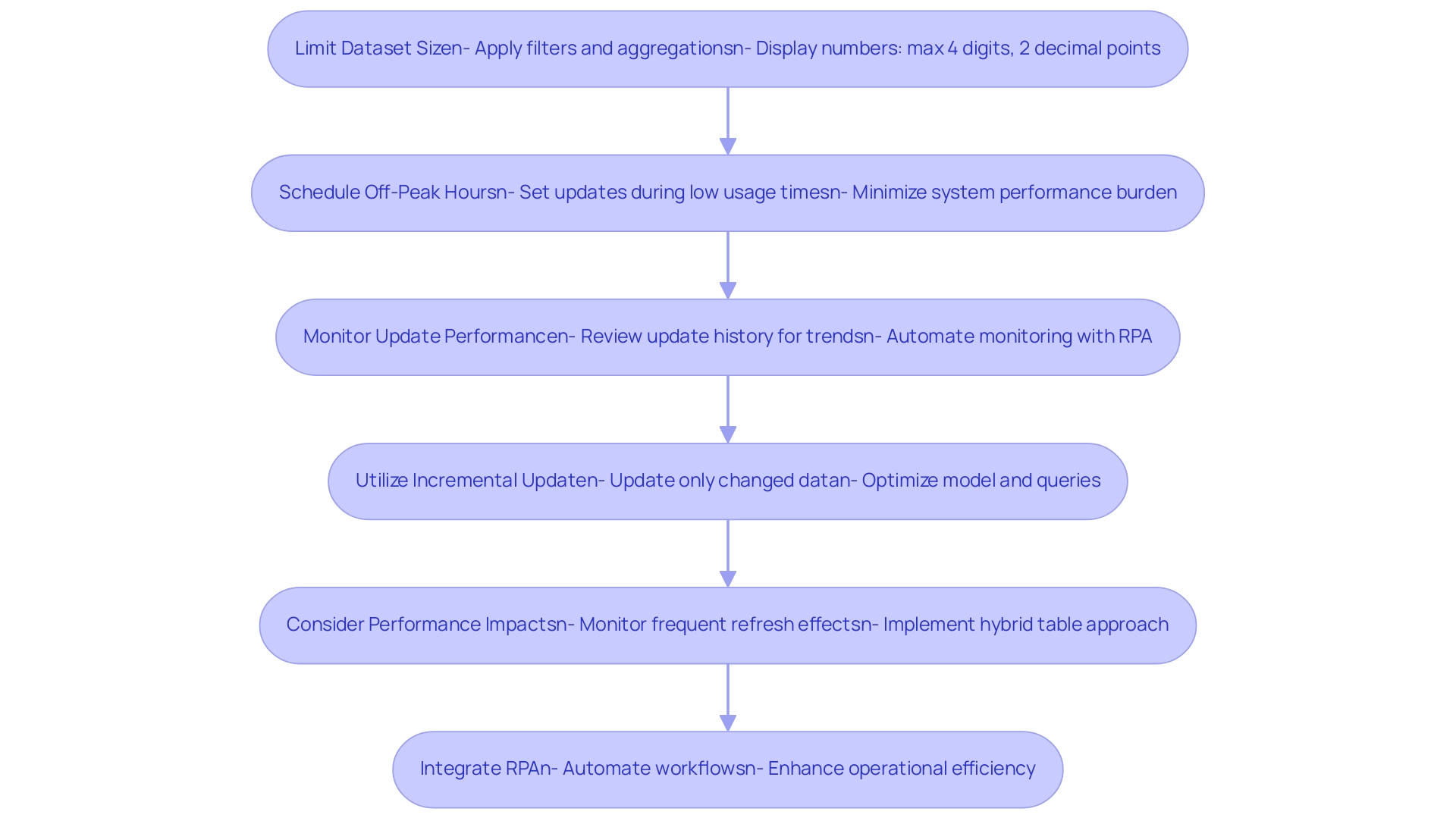
Conclusion
Implementing scheduled refresh in Power BI is a vital step towards ensuring that organizations remain agile and data-driven in decision-making. By automating data updates, teams can eliminate the potential for human error and enhance the consistency of reports, addressing common challenges in data management. The prerequisites for setting up a scheduled refresh include:
- Having a Power BI Pro license
- Compatible data sources
These prerequisites provide a solid foundation for optimizing data operations.
Following a structured approach to configuring scheduled refresh not only streamlines the reporting process but also enables teams to focus on strategic initiatives rather than repetitive tasks. Troubleshooting common issues, such as:
- Refresh failures
- Long refresh times
is essential for maintaining a reliable data environment. By adopting best practices, including:
- Limiting dataset size
- Scheduling refreshes during off-peak hours
organizations can significantly enhance the efficiency of their data operations.
Incorporating innovative tools like Robotic Process Automation (RPA) further empowers teams to optimize their workflows, ensuring that data-driven insights are readily available for informed decision-making. Embracing these strategies will not only improve operational efficiency but also foster a culture of accurate data reporting, ultimately driving growth and innovation within the organization. As the landscape of business intelligence continues to evolve, mastering scheduled refresh capabilities in Power BI will be crucial for sustaining a competitive edge.

